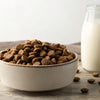Is a Dry Food Diet Good for Dogs? Understanding the Benefits and Considerations
- Houndsy
Table of Contents
- Introduction
- The Nutritional Landscape of Dog Food
- Comparing Dry Food to Wet and Raw Diets
- Selecting the Right Dry Food
- Enhancing the Feeding Experience with Houndsy
- Conclusion
Introduction
Did you know that approximately 60% of dogs in the United States are classified as overweight or obese? This startling statistic not only highlights the growing concern over pet health but also emphasizes the crucial role that diet plays in our furry companions' lives. As pet owners, we often find ourselves grappling with the question: Is a dry food diet good for dogs? This inquiry is vital as we strive to provide our pets with the best nutrition possible.
In recent years, the conversation around dog nutrition has expanded significantly. We’re faced with numerous options: dry kibble, wet food, raw diets, and more. Each feeding choice comes with its own set of advantages and potential drawbacks. Today, we aim to explore the merits and considerations of choosing a dry food diet for our dogs, while also considering how Houndsy’s innovative solutions can enhance the feeding experience.
By the end of this post, you will learn about the nutritional benefits of dry dog food, its impact on dental health, and how it compares with wet food and raw diets. We’ll also discuss practical tips for selecting quality dry food and how our Houndsy Kibble Dispenser can simplify and elevate the feeding ritual for both you and your dog.
The Nutritional Landscape of Dog Food
Understanding Dry Dog Food
Dry dog food, commonly referred to as kibble, is a staple in many pet households. It is formulated to meet the nutritional needs of dogs while being convenient for pet owners. Kibble typically contains a mixture of proteins, carbohydrates, fats, vitamins, and minerals, all designed to provide a balanced diet. But what makes dry food a popular choice among pet owners?
- Convenience: Dry food is easy to store and can be left out for longer periods without spoiling. This makes it ideal for dogs that prefer to graze throughout the day.
- Cost-Effectiveness: Generally, dry dog food is more affordable than wet food, making it a budget-friendly choice for many families.
- Portion Control: Kibble can be easily measured, ensuring that your dog receives the appropriate amount of food based on their weight and activity level.
- Dental Health Benefits: Chewing dry kibble can help reduce plaque and tartar build-up on your dog’s teeth, promoting better oral health.
Nutritional Composition of Dry Food
The composition of dry dog food varies significantly between brands and formulations. High-quality dry food should contain a good balance of:
- Protein: Essential for muscle growth and repair.
- Fats: Necessary for energy and healthy skin and coat.
- Carbohydrates: Provides energy and supports digestive health.
- Vitamins and Minerals: Crucial for overall health and well-being.
When selecting a dry food, it's important to read labels carefully. Look for meat as the first ingredient and avoid products that list fillers or by-products.
The Importance of Quality Ingredients
Not all dry dog foods are created equal. The quality of ingredients plays a significant role in the nutritional value of the food. High-quality dry foods use real meat sources, whole grains, and vegetable ingredients, while lower-quality options may rely heavily on fillers and artificial additives.
How Dry Food Supports Health
Research indicates that a balanced dry food diet can provide several health benefits:
- Weight Management: Kibble can be formulated to be lower in calories, which can help maintain a healthy weight.
- Digestive Health: Many dry foods include fiber sources, such as beet pulp, that support digestive health.
- Skin and Coat Condition: Essential fatty acids in dry food can contribute to a healthy coat and skin.
Comparing Dry Food to Wet and Raw Diets
Dry Food vs. Wet Food
Wet dog food is often praised for its palatability and moisture content, making it a popular choice for picky eaters or dogs needing additional hydration. However, it has its own set of considerations:
- Moisture Content: Wet food contains significantly more moisture than dry food, which can be beneficial for dogs who may not drink enough water.
- Palatability: Many dogs find wet food more appetizing due to its aroma and texture.
- Shorter Shelf Life: Once opened, wet food must be refrigerated and used within a few days, which is less convenient than dry food.
Dry Food vs. Raw Diets
Raw diets, which consist of uncooked meat, bones, and vegetables, are touted for their natural, unprocessed ingredients. However, there are important factors to weigh:
- Nutritional Balance: Formulating a balanced raw diet can be complex and may require veterinary guidance to ensure it meets all nutritional needs.
- Bacterial Risks: Raw food diets can pose a risk of bacterial contamination for both pets and humans handling the food.
- Convenience: Preparing raw food can be time-consuming compared to the convenience of serving dry kibble.
Mixed Feeding Approach
Many pet owners choose to mix dry and wet food to provide their dogs with the benefits of both. This approach can enhance palatability and ensure hydration while maintaining the convenience of dry food.
Selecting the Right Dry Food
Key Considerations
When choosing dry food for your dog, consider the following factors:
- Age and Size: Different life stages (puppy, adult, senior) have unique nutritional needs. Additionally, larger breeds may require specific formulations to support joint health.
- Health Conditions: Some dogs may have special dietary needs due to allergies, sensitivities, or health conditions. Consult your veterinarian for tailored recommendations.
- Brand Reputation: Opt for brands that are transparent about their ingredient sourcing and manufacturing processes. Researching customer reviews and seeking veterinarian recommendations can guide your choices.
Reading Labels
Understanding pet food labels is crucial for making informed decisions. Look for:
- Guaranteed Analysis: This provides information on the protein, fat, fiber, and moisture content.
- Ingredient List: Ingredients are listed in descending order by weight; the first few should be high-quality protein sources.
- Nutritional Adequacy Statement: This indicates that the food meets the standards set by the Association of American Feed Control Officials (AAFCO).
Enhancing the Feeding Experience with Houndsy
At Houndsy, our mission is to simplify and elevate the dog feeding experience. Our flagship product, the Houndsy Kibble Dispenser, embodies our commitment to convenience, design excellence, and pet well-being.
Features of the Houndsy Kibble Dispenser
- Perfect Portion Control: Our dispenser allows you to deliver consistent portions every time, ensuring your dog receives the right amount of food for their size and activity level.
- Standing Height Convenience: The ergonomic design allows for easy access without the need to bend down, making mealtime easier for pet owners.
- Large Storage Capacity: With a capacity of 25-30 lbs, our dispenser keeps food fresh and accessible while complementing your home decor with its mid-century modern design.
- BPA-Free Liner: This feature ensures that food remains fresh and free from harmful chemicals.
By integrating the Houndsy Kibble Dispenser into your feeding routine, you can elevate the everyday experience for both you and your furry friend.
Conclusion
In conclusion, choosing a dry food diet for your dog can provide numerous benefits, including convenience, cost-effectiveness, and potential dental health advantages. However, it’s crucial to select high-quality products that meet your dog’s specific nutritional needs.
As we navigate the complexities of canine nutrition, we invite you to consider how Houndsy can enhance your dog’s feeding experience. Our Houndsy Kibble Dispenser is designed to simplify mealtime while ensuring your pet receives the nutrition they deserve.
FAQs
1. Is dry dog food better than wet food? Both dry and wet dog foods have their benefits. Dry food is typically more convenient and can support dental health, while wet food provides additional moisture and is often more palatable. The best choice depends on your dog’s individual needs.
2. Can I mix dry and wet dog food? Yes! Mixing dry and wet food can combine the benefits of both and can help encourage picky eaters to consume their meals.
3. How do I know if I'm feeding my dog the right amount? Consult your veterinarian for guidance on your dog’s specific dietary needs and caloric intake. Monitoring your dog's weight and body condition score can also help determine if you are feeding the right amount.
4. How do I choose the best dry food for my dog? Look for high-quality ingredients, ensure that it meets AAFCO standards, and consider your dog’s age, size, and any health conditions. Reading labels carefully can provide insight into the quality and nutritional value of the food.
5. Can dry food help with my dog’s dental health? Yes, the texture of dry kibble can help reduce plaque and tartar build-up, promoting better oral health when combined with regular dental care.
We hope this comprehensive guide has illuminated the topic of dry dog food diets and empowered you to make informed decisions for your beloved pet. Happy feeding!












